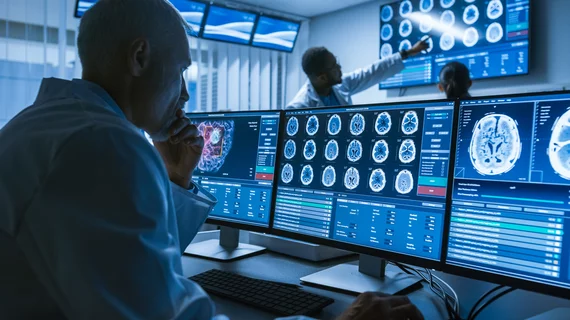Lower shift volumes lead to significantly fewer errors for neuroradiologists
Lower shift volumes lead to significantly fewer errors for neuroradiologists, according to new research.
Unlike Europe or Japan, radiological society recommendations for workflow management to reduce error rates are lacking in the U.S., researchers detailed in the American Journal of Neuroradiology [1]. Experts sought to better understand this issue, analyzing CT and MR from on UC Davis’ Neuroradiology Quality Assurance database, spanning 2014 to 2020.
They found that the lowest error rates were observed for physicians limited to 19 to 26 studies per shift. When the case volume increased to 67-90 studies, error rates rose by 226% compared to those handling 19 or fewer cases.
“Limiting the number of studies per shift to a low range, as opposed to high, unregulated volumes, should allow for the prevention of a significant number of diagnostic neuroradiology errors,” lead author Vladimir Ivanovic, MD, with the Department of Radiology at the Medical College of Wisconsin in Milwaukee at the time of the study, and colleagues concluded.
For the study, researchers queried the database for all attending physician errors. The search turned up a total of 643 mistakes, with nearly 92% deemed as clinically significant (having a RadPeer score of 2B or 3B). Neuroradiologists in the study had an overall error rate of 2.36 per 1,000 CT and MR examinations. For those that read 26 or fewer studies during a shift, the error rate was 1.59 per 1,000, while it leapt to 2.58 when going over 26 reads.
“Radiologist workloads have been steadily increasing over recent decades,” Ivanovic and colleagues wrote. “If we can develop more uniform policies and hospital business models in which shift volume limits and subspecialized interpretations are incentivized to act synergistically, as has been successfully done at many institutions across the country, the error reduction rates might approximate those of the airline industry or anesthesia departments.”
At the authors’ own institution, the first step has been to reduce the effect of extreme shift volumes by adjusting workflow without increasing shift frequency. As part of the process, researchers encouraged flexibility toward a labor division based on seniority level and experience with certain types of neuroradiology studies.
“Promoting educational and research efforts, multidisciplinary consultations, and peer review discussions allows us to maintain our focus on quality and deepening our expertise,” the study noted. “Mid- and long-term goals of limiting shift volume within the 19-26 range should then facilitate adjustments to the traditional business models and should thereby result in increased job attractiveness and more effective support to cohesive and motivated teams while maintaining profitability.”
Neuroradiologist and blogger Ben White, MD, shared the study on social media Sunday. He expressed skepticism that institutions could achieve such a range.
“It's unrealistic,” White told Radiology Business by email. “Assuming a mix of CT and MR, it's well below average in terms of the RVU generation needed for expected compensation. More importantly, it's unrealistic given the reality of the large and growing volume of cases hospitals and imaging centers generate that radiologists need to interpret to get the clinical work done. ~20 cases is well below what I believe even the lowest volume producers would be expected to interpret in a day, comically so for any hospital-style call-type shift.”
Ivanovic stood by this aspirational goal and believes the field can achieve it.
“There are numerous large institutions that are able to couple high level care and low shift volumes at a healthy profit—Mayo Clinic and Cornell are just a few of these. So, it can be done!” he told Radiology Business by email. “My hypothesis is that, most expensive care in the long run is inaccurate care. The questions are: Who has a more competitive model (high- vs. low-volume camps)? How can the rest of the country’s institutions develop a business strategy that matches Mayo or Cornell? And if they do not, will they survive as independent entities or be taken over by institutions that have more efficient model with better patient outcomes?”
Read more about the study, including potential limitations, in AJNR at the link below. Ivanovic also wrote another study on this topic last year in the American Journal of Roentgenology.

